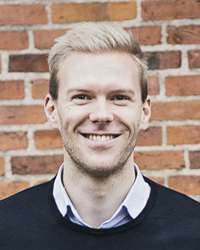SonoEX (2021-2022)
Work procedures with unilateral repetitive movements, e.g. scanning, increase the risk of developing work-related muscle and skeletal pain, which leads to reduced work function and risk of illness.
PROJECT PERIOD
Start: June 2021
End: July 2022
Exoskeletons are mechanical skeletons that the wearer puts on to reduce the risk of muscle and joint damage. The spring system in a passive exoskeleton means that the user is relieved by up to 5 kilos per arm, which for many will mean that the arms are weightless.
Over an extended period of unilateral repetitive motion or static work positions it is expected to reduce injuries related to overuse and overloading.
AIM
The purpose of the project was to test the exoskeleton in relieving sonographers in connection with ultrasound scans of pregnant women. The expectation was that the staff would experience better work function and less pain, which was expected to result in greater job satisfaction as well as less illness as a result of overloading of the neck and shoulders in particular.
The project had the following deliverables:
- Practical testing of exoskeletons in clinical practice
- Evaluation based on the practical test
- Identification of the need for further development of exoskeletons when they are to be used in clinical practice
- Evaluation report
Experiences from the project were meant to form the basis for possible implementation of exoskeletons at OUH.
RESULTS
Objective muscle response measurements (EMG) showed an effect in the form of reduced muscle activity when the sonographers used the exoskeleton during scans.
However, the qualitative evaluation showed that after the test, the sonographers did not believe that the exoskeleton is a suitable technology to remedy their work-related injuries and support them in their daily work. This is mainly due to the fact that during the test, it turned out that their challenge is primarily the pressing down during scans and not the static hold with raised arms, as was thought before the project.
However, they view the project very positively, which they perceive as a step on the way to finding technologies and methods that can improve their working conditions and reduce the risk of work-related injuries to the musculoskeletal system.
PARTNERS
The project was carried out at the Department of Gynaecology and Obstetrics at Odense University Hospital (OUH).
From OUH, the Human Resources Department, Department of Occupational and Environmental Medicine, Department of Clinical Microbiology, Facilities Management and Department of Clinical Development also participated.
Evaluation, including objective EMG measurements, was carried out by the Research Unit for Physical Activity and Health in working life at the University of Southern Denmark in collaboration with Occupational Medicine at Regional Hospital Herning.
FUNDING
The project was funded by the internal Innovation Fund at OUH.

Malte Kongstad Deleuran
Innovation Consultant
Odense University Hospital, Department of Clinical Development - Innovation, Research & HTA
(+45) 2165 7146 mkd@rsyd.dk
